List of monasteries, monasteries and commanderies in Mecklenburg-Western Pomerania
The list of monasteries, monasteries and commanderies contains former and existing branches of the order in today's Mecklenburg-Western Pomerania .
Monasteries, monasteries and commanderies
| Surname | Location coord. |
founding | medal | Special features, later use | Illustration |
|---|---|---|---|---|---|
| Nunnery on the Mecklenburg | Mecklenburg (castle) | 10th century | Benedictine | The monastery existed at the Petrikirche in the castle and was led by the Abodritic princess Hodica as abbess. | |
| Stolpe Monastery |
Stolpe coord. |
1153 | Cistercians | Founded as a Benedictine monastery in 1153 by Duke Ratibor I and Bishop Adalbert von Pomerania . In 1304 the convent converted to the Cistercian order under Abbot Ditmar. Secularized after the death of the last abbot Matthias in 1534. In the Thirty Years' War in fighting around the town of Anklam in 1637 destroyed by fire. To Sweden in 1648, to Prussia in 1720, privately owned in 1807. Ruins of the western tower substructure exist. |

|
| Grobe Monastery |
Usedom Coord. |
before 1155 | Premonstratensians | Founded by Duke Ratibor I after 1150, the monastery was already deserted in 1177. Relocation to Pudagla approved by Duke Bogislaw IV. 1307 completed in 1309. Disbanded in the course of the Reformation in 1535 and converted into an office. | |
| Dargun Monastery |
Dargun coord. |
1172 | Cistercians | Relocated to Eldena in 1199, resurrection with Doberan Cistercians in 1209, secularization from 1552 to 1556 , then conversion to a renaissance castle complex, church and castle almost completely destroyed by arson in 1945, now partially used after the ruins were secured |

|
| Doberan Monastery |
Bad Doberan Coord. |
1171 | Cistercians | Founded by Bishop Berno and Prince Pribislaw in 1171 in Althof (Alt Doberan) , rebuilt by Heinrich Borwin I in 1186 in what is now Doberan, in 1552 not only Doberan but also the Doberan court in Rostock was secularized, looted and damaged in 1637, some monastery buildings demolished and the bricks in the palace used in Güstrow. |
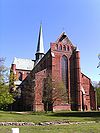
|
| Bergen monastery on Rügen |
Bergen on Rügen Koord. |
1193 | Benedictines / Cistercians | Founded by Prince Jaromar I of Rügen in 1193 as a Benedictine monastery, it was continued as a Cistercian monastery in 1250 and was confirmed by Pope Innocent IV . After fierce resistance, it was converted into an evangelical aristocratic women's monastery in 1569 , devastated and looted in the Thirty Years War, then hospital and military hospital, reopened in 2005 as a cultural meeting place. |

|
| Eldena Monastery (Western Pomerania) |
Eldena (Greifswald) coord. |
1199 | Cistercians | 1204 by Pope Innocent III. approved. The most important achievement was the founding of Greifswald in the first half of the 13th century and the establishment of Greifswald University in 1456 with the help of Abbot Sabellus. In 1535 the abbey was abolished and turned into a princely office. Most of the demolition of the enclosure took place during the Thirty Years' War. |
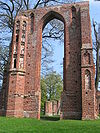
|
| Eldena Monastery (Eldena) | at Eldena in the Ludwigslust-Parchim Koord district. |
since 1229 | Benedictines / Cistercians | Founded between 1229 and 1235 by Bishop Gottschalk von Ratzeburg and confirmed in 1291 by Bishop Konrad von Ratzeburg . First documented mention in 1307, Duke Rudolf I donated the Conow saltworks to the monastery , and Antonia von Winterfeld was the prioress in 1527 . In 1555 the nunnery was secularized, the property became a princely domain , and in 1588 the monastery was dissolved. |

|
| Sonnenkamp Monastery |
Neukloster Koord. |
1219 | Benedictines / Cistercians | Founded as Sonnenkamp Monastery by Prince Heinrich Borwin I around 1211 in Parkow as a Benedictine monastery. In 1245 the rules of the order of the Cistercian women were introduced. During the Reformation the monastery was secularized in 1555 and then passed into the possession of Duke Ulrich . |

|
| Dobbertin Monastery |
Dobbertin Coord. |
before, after 1220 | Benedictine / Benedictine | 1220 monastery (OSB), 1234 nunnery of the same order, 1566 long-term resistance of the nuns to the Reformation, despite all attempts of the Mecklenburg dukes and visitors in 1570 still Catholic. 1572 Conversion into an evangelical aristocratic women's monastery, 1918 dissolution of the state monastery, 1920 transferred to the Free State of Mecklenburg-Schwerin , 1945 occupied by the Soviet Army, 1947 state retirement and nursing home, 1962 branch of the Schwerin District Nervous Clinic, 1991 Diakoniewerk Kloster Dobbertin gGmbH, from 1992 to 2016 monument - and handicapped accessible renovation of the entire monastery complex. Internal restoration of the monastery church is currently underway. |

|
| Tempzin Monastery |
Tempzin coord. |
1222 | Antonites | Founded by Prince Heinrich Borwin I in 1222, the hospital was the only Antonite settlement in northern Germany. Secularized in 1550, the monastery church converted into an evangelical parish church in 1589, the warm house from 1496 was a hospital. At the beginning of the 20th century a barn, now a meeting place and pilgrim hostel . |

|
| Commandery Mirow |
Mirow coord. |
1226 | Johanniter | Developed into a commandery by 1242 at the latest, the monastery was a knight and priest coming, since 1552 commandery reserved for the princes of Mecklenburg, after a long dispute in 1648 it was secularized. The commandery building was expanded between 1749 and 1760 as a palace for the princely residence, the church, which was destroyed in 1945, was rebuilt in 1951. |

|
| Commandery Kraak |
Kraak coord. |
1217 | Johanniter | Founded in 1217 in Sülstorf , church building with Sülstorfer Komtur in 1275, moved to Kraak around 1315 and the seat of the Komtur there. 1552 abolition and secularization, 1553 to Ritter Spedt, 1562 Johanniter building as a hunting lodge owned by the sovereign, only churches in Sülstorf and Kraak remain. |

|
| Rehna Monastery |
Rehna Coord. |
1230 | Benedictines / Premonstratensians | Founded as a Benedictine monastery by Frater Ernestus, confirmed by Bishop Ludolf von Ratzeburg in 1237 , transition of the convent to the Premonstratensian order in 1319, secularized in 1552, personal belongings of dowager dukes and princesses from 1576 to the 18th century , then official building until 1819, forest office until World War I , later school, after 1997 renovation and official building. |

|
| Rühn Monastery |
Rühn Coord. |
1232 | Benedictines / Cistercians | Founded as a Benedictine monastery by Bishop Brunward von Schwerin in 1232, after visitations in 1549 and 1557 it was converted into an evangelical aristocratic women's monastery, to which a girls' school was affiliated in 1581. Destroyed in the Thirty Years' War, partially rebuilt, closed by Duke Christian Ludwig II in 1756 and then the seat of the ducal Domanialamt Bützow-Rühn, 1876–1927 von Voss family , orphanage after the Second World War , youth workshop from 1950 to 1990 , vacant since 1991, from 2008 renovation by the monastery association Rühn. |

|
| Franciscan monastery Schwerin | Schwerin | 1236 | Franciscan | Construction of the church completed in 1287, the church closed in 1548/50, secularized in 1552, then castle and princely school, soon partial demolition, later chancellery and granary, today college house. | |
| Commandery Krankow | Klein Krankow | 1240 | German medal | Year of foundation unknown, between 1268 and 1355 temporary seat of a commander in Mecklenburg, 1330 branch with religious court and chapel in Wismar until 1356, commandery Krankow sold in 1356 to the knight Markwart von Stove. | |
| Katharinenkloster Rostock |
Rostock Coord. |
1243 | Franciscan | There is evidence of Franciscans in Rostock since 1234, the church was named in 1269 and the monastery in 1285. Church closed in 1531, lifted in 1534, then poor house, orphanage, in the town fire in 1677 the monastery church burned down to the choir , later a military hospital, penitentiary, industrial school, “lunatic asylum”, in the 20th century old people's home, after extensive renovation from 1998 to 2001 the music academy and theater . |

|
| Franciscan monastery Parchim | Parchim | 1246 | Franciscan | First mentioned in 1246 between Parchimer Old Town and New Town, 1278 letter of protection issued by Johann I (Werle) , 1347 dispute between Parchim clergy and the Franciscans that went as far as Rome. 1540 closure of the church, after the introduction of the Reformation the monastery was deserted, secularized in 1552, then a school, in 1560 demolition of some buildings, the stones were used to build the fortress Dömitz . | |
| Broda Monastery |
Neubrandenburg Coord. |
1170/1240 | Premonstratensians | Prince Casimir I founded the monastery in 1170, it was built in 1240 and was a canon of the Premonstratensian Order. In 1276 the Provost von Broda founded the school brotherhood in Neubrandenburg. 1537 inventory of the monastery assets, secularized in the course of the Reformation in 1551 and converted into a ducal office, the last medieval building remains removed in the 18th century. |

|
| Katharinenkloster Stralsund |
Stralsund Coord. |
1251 | Dominican | Prince Jaromar II of Rügen founded the monastery in 1251. Construction of the church completed in 1317, in the course of the Reformation in 1525 the church and the monks' cells were badly demolished. When the church in Stralsund was broken up , the Brigittines von Marienkrone were assigned to the monastery, from 1560 high school and orphanage, 1678 used by the Swedes as an arsenal , then an armory. In 1902 the monastery church went to the city, since 1953 the Kulturhistorisches Museum Stralsund , today's German Sea Museum . |
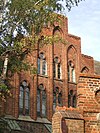
|
| Johanniskloster Stralsund |
Stralsund Coord. |
1254 | Franciscan | Through Prince Jaromar II, Franciscans began building the monastery in 1254. In 1525 the monastery was looted, the church was devastated, altars and pictures destroyed. After the abolition in 1552, the city took over the property, then the poor house and hospital. 1624 church burned down, 1825 deaf-mute institution, 1944 air raid destroyed the choir, from 1963 Stralsund city archive , library and concert hall. |

|
| Franciscan monastery Güstrow | Guestrow | 1509 | Franciscan observers | Founded in 1509 on the site of the Heiligen-Bluts-Kapelle, which was destroyed by fire in 1503. The church was closed in 1550, secularized and dissolved in 1552, followed by a school; the name Klosterhof was retained . | |
| Augustinian monastery Ueckermünde | Ueckermünde | 1260 | Augustinian Canons | Augustinian canons of the Congregation of St. Viktor in Paris settled in Ueckermünde in 1260. Duke Barnim I equipped the new foundation with 60 hooves in the Sidelowe heath and in 1270 granted it the patronage of the parish church of St. Nikolai, but in 1276 the monastery was relocated to Gobelenhagen (Hagen) near Pölitz. | |
| Marienberg Monastery | Altentreptow | Late 12th century | Benedictine women | As the oldest women's monastery in Pomerania at the end of the 12th century by Heinrich and Borts, the sons of the Lutizen prince Rannus in honor of St. Virgo founded. Bishop Sigwin von Kammin confirmed the foundation in 1191/94, in 1239 after Klatzow. | |
| Klatzow Monastery | Klatzow ad Tollense | 1239 | Benedictine women | First mentioned in 1239, as Duke Wartislaw III. awarded the Hohenmocker Church to the Clatzow nuns . The church was dedicated to Mary, John the Evangelist and St. Elisabeth. The nuns left Clatzow as early as 1245 and moved to Marienwerder in the Peene near Verchen. In 1257 Pope Alexander IV took the monastery and the Benedictine order under his protection. The nuns went to Verchen in 1269. | |
| Verchen Monastery | Forgive | 1191/1194 | Benedictines / Community of Christ Brotherhood | Oldest Pomeranian women's monastery, founded around 1191/94 by Heinrich and Borts Rannus on the Klosterberg , formerly Marienberg near Altentreptow . The nuns came from Marienwerder to Verchen on Lake Kummerower in 1269. 1270 Start of building the church, 1462 Marian Brotherhood, in the course of the Reformation 1534 inventory by Duke Barnim IX. Since 2004 Order Community Christ Brotherhood Selbitz . |

|
| Dominican monastery Greifswald | Greifswald | 1254 | Dominican | Prince Wartislaw III. founded the monastery in 1254, in 1517 Pope Leo X assigned the monastery to the province of Saxonia . The convent achieved an excellent reputation, which remained until it was dissolved in the 16th century. In 1517/18 there was a study of logicae in the monastery and in 1519 a study of theologiae . Secularized in 1534, the Dominicans stayed until 1562. After a dispute over ownership of the monastery buildings, the university received all the buildings in 1566. Today nothing of it has survived. | |
| Dominican monastery Pasewalk | Pasewalk | 1277 | Dominican | Founded in 1277 by the Margraves of Brandenburg, who owned Pasewalk in 1250. The convent belonged to the Dutch Congregation in the 15th century. The dissolution of the monastery began in 1532 due to the abuse of the religious during the riot in the city and ended in 1535 after the church visitation. The buildings of the monastery fell into disrepair, today there is only one monastery street . | |
| Franciscan monastery in Neubrandenburg | Neubrandenburg | 1248 | Franciscan | Documented mention in 1287, burnt down twice in 1335, construction of the infirmary in 1435, church closed in 1535. The monastery was closed between 1540 and 1552. 1567 to the city to be set up as a hospital for poor noblemen and those in need, then a city retirement home, today a regional museum .
Re-establishment 1998-2004, then relocation to Waren (Müritz) |

|
| Gardow Commandery | Gardow | 1285/86 | Johanniter | Margrave Albrecht III. In addition to some villages in 1285, the Feldmark Gardow near Fürstenberg also handed over the Order of St. John. The first Komtur in Gardow was Ulrich Swabe. The Commandery went to Klein Nemerow in 1322 (see Commandery Nemerow ). The village went under after 1583. The Comthurey Vorwerk, which was built in modern times, is reminiscent of the former Johanniter settlement . | |
| Commandery Nemerow | Great Nemerow | 1298 | Johanniter | Commander Ulrich Swabe founded a commandery in 1298 in the village of Klein Nemerow he had acquired. The property of the Gardow Commandery was incorporated, and a priestly priory was established. Secularized in 1552, property went to Jochim von Holstein, the church on the Commandery was converted into a chicken house, until 1693 protests by the order, today only ruins of the monastery barn remain. |
|
| Guestrow Abbey |
Guestrow Coord |
1226 | Kollegiatstift | Founded in 1226 by Prince Heinrich Borwin II . The Güstrower Kollegiatstift was a foundation belonging to the diocese of Cammin . Dompropst Gerd Oemke had headed the chapter since 1547, he was friends with Luther and in 1550 campaigned for the abolition of the collegiate foundation at the Sternberg state parliament. Repealed in the course of the Reformation in 1552. |

|
| Bützow Abbey |
Bützow Coord |
1248 | Kollegiatstift | Bishop Wilhelm von Schwerin raised the Bützow main church to one of St. Maria, St. Evangelists John and St. Elisabeth cathedral with the collegiate monastery. In 1378 a collegiate school was named, after the secularization between 1532 and 1540, a Protestant parish church. |

|
| Strelitz Abbey | Strelitz-Alt | before 1355 | Premonstratensian Collegiate Foundation | Donated by Otto von Fürstenberg between 1349 and 1355, first documented mention in 1366, again in 1417, only a few reports. | |
| St. Jacobs Monastery Rostock |
Rostock Coord |
1487 | Kollegiatstift | Erected by Duke Magnus II in 1487 after a violent dispute with the city. During the riot on the occasion of the inauguration in 1487, the provost and ducal chancellor was slain. The collegiate foundation consisted of 12 canons. In 1531 the city council pushed through the Reformation. The cathedral was badly damaged in 1942, the side aisles were demolished in 1957, the choir was demolished in 1959 and the remaining parts of the tower were removed in 1960. |

|
| St. Nikolaus Abbey in Greifswald |
Greifswald Coord. |
1456 | Kollegiatstift | With the establishment of the Greifswald University in 1457, the Nikolaikirche was elevated to a collegiate church by the Camminer Bishop Henning Iven . The provost was head of the monastery and the Greifswald clergy and exercised jurisdiction over clergy and laypeople according to canon law. The collegiate canons were lecturers and many of them were rectors of Greifswald University; the collegiate church was also the university church. With the introduction of the Reformation, St. Nikolai lost its character as a collegiate church and its connection with the university. St. Nikolai is now a Protestant cathedral. |

|
| Malchow Monastery |
Malchow coord. |
before 1274 | Magdalenerinnen (penitents) / Cistercians | Founded before 1274 as a monastery of penitents in Neu Röbel, moved from Schwerin to Alt Malchow in 1298 by Bishop Gottfried I. , first mentioned in a papal document in 1274 converted into a Cistercian monastery. After the Reformation in 1572, it was converted into an evangelical aristocratic women's monastery, transferred to the Free State of Mecklenburg-Schwerin in 1920, monastery building used as apartments from 1945, today the Mecklenburg Organ Museum in the Gothic church built in 1888/90 . |
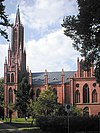
|
| Bethlehem Monastery | Bützow | 1468 | Sisters of Life Together / Augustinians | Founded by Augustinians of the Lübeck Segeberghaus and the Michaeliskonvent in Bützow in front of the Rostocker Tor in 1468, confirmed by Bishop Werner Wolmers von Schwerin in 1469 with an order. After the Reformation in the Stiftsland Bützow, the monastery was converted into a hospital (Raths-Armenhaus) by Elisabeth, the wife of Duke Ulrich . The sisters of common life lived according to the rules of St. Augustine. | |
| Zarrentin Monastery | Zarrentin | 1246 | Cistercian women | Founded in 1246 by Countess Audacia von Schwerin and son Count Gunzelin III. , Confirmed in 1252 by Bishop Friedrich von Ratzeburg. 1282 Princess Margaret of Denmark joins the convent, 1535 church visit. On the orders of Duke Johann Albrecht I, the monastery was abolished in 1555, then a granary, brewery, district administration and district court, stallion depot, youth hostel, after 1945 barracks, apartments and communal facilities. |

|
| Neuenkamp Monastery |
Franzburg Coord. |
before 1231 | Cistercians | Founded by Prince Wizlaw I of Rügen in 1231, settled in 1233/34 by monks from the Cistercian monastery in Altenkamp , before 1300 the convent was moved to Franzburg and the church was built, and later a hospital. 1525 visitation, 1534 dissolution of the monastery by Duke Philip I , Neuenkamp became a sovereign domain. Abbot Johann Molner received the Kampischer Hof in Stralsund as his home in 1534 . In 1578 Duke Bogislaw XIII built. instead of the monastery a castle and in 1587 laid out a town next to it. |
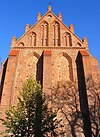
|
| Krummin Monastery | Crooked | 1302/03 | Cistercian women | Founded by Prince Bogislaw IV of Pomerania in 1302/03 as a subsidiary of the Cistercian abbey in Wollin on the Krumminer Wieck, in 1305 the mother monastery was renounced. The village church , built around 1260/70, became a monastery church and was a pilgrimage destination in the Middle Ages. 1563 Dissolution of the monastery by Duke Johann Friedrich , then subordinated to Wolgast. |

|
| Schwerin Cathedral |
Schwerin Coord |
before 1171 | Cathedral chapter St. Maria, St. Johannis | Construction of the bishop's church from 1171 with Bishop Berno , consecration of the church in 1248, beginning of the construction of the Schwerin Cathedral around 1270. The cathedral chapter was not bound by an enclosure, had twelve high cathedral clergy, a cathedral provost with a cathedral provost. 1559 Domherrenhöfe for clergymen and church servants. 1552 first Protestant service in the cathedral, 1648 dissolution of the Schwerin cathedral chapter. |

|
| Benedictine monastery in Wismar | Wismar | 1239 | Benedictine | The Benedictine monastery is said to have been founded between 1180 and 1239, but this cannot be documented. Probably confused with the name of the Benedictine monastery Cismar . | |
| Franciscan monastery Greifswald | Greifswald | 1262 | Franciscan | Founded in 1262, in 1348 renewal of the church choir and stalls by Greifswald patrician families, in addition to monastery buildings, a brewery and a beguinage. Secularized in 1556. The last Guardian, Simon Kamen, handed the monastery over to the City Council with seals, documents and the library. In the Seven Years' War Fouragemagazin, 1781-1790 partially broken and the point 1799 big city school, later built high school, since 1929 local museum today Pomeranian State Museum . |

|
| Franciscan monastery Wismar | Wismar | 1251 | Franciscan | Monastery of St. Cross. In 1525, the Wismar Council appointed the Reformation preaching brother Heinrich Never as Guardian , who resigned from the Franciscan order in 1527. Then the dissolution of the Wismar Franciscan convent began. In 1541 the city council built a Latin school, and in 1545 the monastery was completely confiscated. The church remained as a Graumönchen church until 1816, the monastery building was replaced by new school buildings until 1892; Today here Large City School Wismar . | |
| Wanzka Monastery |
Wanzka coord. |
before 1283 | Premonstratensians / Cistercians | By Margrave Albrecht III. founded by Brandenburg. The first sisters presumably Premonstratensian from Broda Abbey , church consecration in 1290, school with boarding school in the monastery in 1341. During the Reformation, properties came under princely administration in 1549, the monastery was abolished in 1555, eight nuns in 1568, and in 1584 as a Protestant monastery. 1833 church fire. |

|
| Ivenack Monastery |
Ivenack Coord. |
Cistercian women | Founded in 1252 by Knight Reinbern von Stove, a large field monastery on Lake Ivenacker. In 1555 two princely officials and a Lutheran preacher were assigned to the last abbess Anna von Kamptz . After secularization in 1556 under sovereign administration as Amt Ivenack, the monastery church destroyed in the Thirty Years War, renewed in 1700 and rebuilt in 1867/68. | ||
| Hiddensee Monastery |
Hiddensee coord. |
1296 | Cistercians | Founded by Prince Wizlaw II of Rügen in 1296 in what is now the monastery , in 1298 the first monks from Neuenkamp monastery moved into the Cisterze , in 1302 a chapel with a tower and beacon was built on the Gellen . 1373 and 1389 fires in the monastery, 1410 re-consecration of the monastery church. 1525 visitation, in the course of the Reformation 1536 conversion to ducal office, during the Thirty Years War the monastery buildings fell into disrepair. | |
| Poor Clare Monastery Ribnitz |
Ribnitz-Damgarten Coord. |
1323 | Poor Clares | Monastery construction from 1325 as a foundation of Heinrich II. (Mecklenburg) , 1329 move in of the first nuns. In December 1599 it was converted into a Protestant women's monastery. An exhibition on the history of the monastery and the monastery and the German Amber Museum are located in the house of the head of the monastery and in the adjacent buildings. |

|
| Black Monastery (Wismar) |
Wismar Coord. |
1293 | Dominican | Founded in 1293 by Dietrich von Hameln, construction of the monastery 1319–1329 and church choirs 1381–1397. The Wismar Dominicans achieved a high reputation. 1562 liquidation deed of the convent, the monastery became a poor house, in 1689 the church an orphanage. Citizens' school since 1880, a gymnasium in the church choir and the auditorium above, the church demolished in 1875–1878, today remains of the refectory in the courtyard. |

|
| Holy Cross Monastery (Rostock) |
Rostock Coord. |
1270 | Cistercian women | According to legend, it was founded between 1269 and 1272 with the participation of Queen Margaret of Denmark, confirmed in 1276 by Pope Innocent V and placed under his protection. 1533 and 1534 first attempts at reform, refusal to change faith until 1562, conversion into an evangelical women's monastery in 1584. In 1920 transferred to the Free State of Mecklenburg-Schwerin, today Rostock Museum of Cultural History. |

|
| Johanniskloster Rostock |
Rostock Coord. |
1256 | Dominican | Founded around 1265, church construction began in 1306 and was not consecrated until 1329. Dissolved in 1531 after the Reformation was implemented, in 1534 the von Bülow family complained about the closure of the convent. The monastery complex was demolished in 1566, the monastery church was only demolished in 1831, remnants removed around 1950. |

|
| Coming oaks |
Mühlen Eichsen Coord. |
around 1200 | Johanniter | Around 1200, Count Heinrich and Gunzelin von Schwerin donated the parish in Eichsen to the order. These possessions formed the main part of the priory . Disputes with the Ratzeburg bishops about the patronage rights ended in 1283 in favor of the Johanniter. Between 1419 and 1508 the priory was a place of pilgrimage, in 1442 Duke Henry IV and his family were accepted into the brotherhood. 1552 abolition of the priory, Duke Johann Albrecht gave possessions to his chancellor Johann von Lucka, from 1560 to Anna Sophie von Brandenburg, the wife of Johann Albrecht. |

|
| Augustinian monastery in Anklam |
Anklam Koord. |
1310 | Augustinians | The monastery church was dedicated to St. Consecrated cross. 1415 joint educational establishment of several Augustinian monasteries. In 1530 the Anklam magistrate took over the monastery. In 1530 the building was damaged by lightning, in 1535 further buildings were demolished after it was closed, and in 1543 two monks were still alive. Nothing left today. | |
| Charterhouse Marienehe |
Rostock Coord. |
1396 | Carthusian | Founded by Rostock mayor Winold Bagget in 1396, the only Carthusian monastery in Mecklenburg, approval by Duke Albrecht III. 1396. Duke Johann Albrecht had the Charterhouse abolished in 1552 by 300 armed men. Demolished by 1559 and the stones used to build Güstrow Castle . |
|
| Michaeliskloster Rostock |
Rostock Coord. |
1462 | Brothers of life together | It housed an important printing and bookbinding shop from the late Middle Ages. Disbanded by 1531, then a student hostel, armory , wool magazine and grain store. Around 1900 it served as a substation, completely burned out in a British bombing in 1942 , restored in the 1950s and given to the Methodist community. The west wing regained its historical appearance in 1994 and serves as accommodation for the Rostock University Library . |

|
| St. Annen and Brigitten |
Stralsund Coord. |
1421 | Order of the Redeemer | 1421 Double monastery for nuns and monks, 1446 beginning of church construction, consecrated in 1470. When the Stralsund church broke down in 1525, the monastery buildings and the chapel were destroyed. The nuns moved to St. Catherine's Monastery in 1525 . In the following years the buildings were rebuilt as half-timbered houses and served as residential buildings for several centuries. Used by the New Apostolic Congregation from 1948–1988, extensive renovation from 2004–2008, now city administration. |

|
| Sternberg Augustinian Hermitage | Sternberg | around 1500 | Augustinian Hermits | Erected as the "Augustinian Hermit Monastery of the Holy Sepulcher " by Duke Magnus II. 1500 on the spot where the wafers stolen and vandalized in the royal court were once buried. 1496 Holy Blood Chapel, 1503 Brotherhood of the Holy Blood and St. Anne. After visiting in 1520, the church was closed in 1524 and the convent was dissolved in 1527. In 1562 the abbess Ursula sent seven pilgrims from the Ribnitz Clare Monastery to Sternberg. | |
| Dominican monastery Röbel | Röbel / Müritz | 1285/87 | Dominican | In succession to the Magdalenerinnenkloster moved to Malchow; Disbanded before 1558, demolished by 1603. | |
| Franciscan monastery goods | Goods (Müritz) | 2004 | Franciscan | Since moving from Neubrandenburg, the Franciscans have been looking after the parish of Heilig Kreuz Waren since 2004 and are active in prison chaplaincy. | |
| Community of Salvatorians | Stralsund | 1997 | Salvatorians | Two sisters live in an apartment in the Caritas senior center St. Josef and work in the pastoral care of the elderly. | |
| St. Otto's home | Zinnowitz | 1916 | Sisters of Mary of the Immaculate Conception / Poor School Sisters of the Third Order of St. Francis Seraphicus (TOR) | Convent in the St. Otto home (meeting and holiday center), 1916–2004 Sisters of Mary, since then convent of the poor school sisters. |
literature
- Wolfgang Huschner , Ernst Münch , Cornelia Neustadt, Wolfgang Eric Wagner (eds.): Mecklenburg monastery book. Handbook of the monasteries, monasteries, coming and priories (10th / 11th - 16th centuries), 2 vols., Rostock 2016 ISBN 978-3-356-01514-0
Individual evidence
- ↑ Wolfgang Huschner: Wismar Monastery Holy Cross. 2016, In: Mecklenburgisches Klosterbuch.
- ↑ salvatorianerinnen.de , accessed on January 8, 2017.
-
↑ st-otto-heim / geschichte
franziskanerinnen.at/geschichte
Schematismus for the Archdiocese of Berlin, 2008, p. 329.
Web links
- Georg Christian Friedrich Lisch : Older history of the Saline zu Conow. [1]